توقعت مجلة فوربس في عام ٢٠١٩ أن ينمو سوق XR ثمانية أضعاف. وبحلول عام ٢٠٢٥، سيتجاوز السوق ٢٠٩ مليارات دولار أمريكي؛ فلماذا اكتسب XR هذا الزخم مؤخرًا؟
السبب الأول هو أن المزيد والمزيد من البرامج التلفزيونية والعروض والأفلام عبر الإنترنت بدأت في استخدام تقنية LED Virtual XR على نطاق واسع، مما ينعش الجمهور.
السبب الرئيسي هو أن “عرض الصمام + تقنية XR تغير تدريجيا الطريقة التقليدية لإنتاج الأفلام والتلفزيون.
بعد قراءة هذا المقال، سوف تتعلم المزيد عن تقنية XR وتطبيقات الإنتاج الافتراضي في 13 فصلاً، بالإضافة إلى ميزانية تكلفة مرحلة XR التي لا يناقشها الناس كثيرًا.
دعنا نذهب~
جدول المحتويات
1.ما هو الواقع الممتد (XR)؟
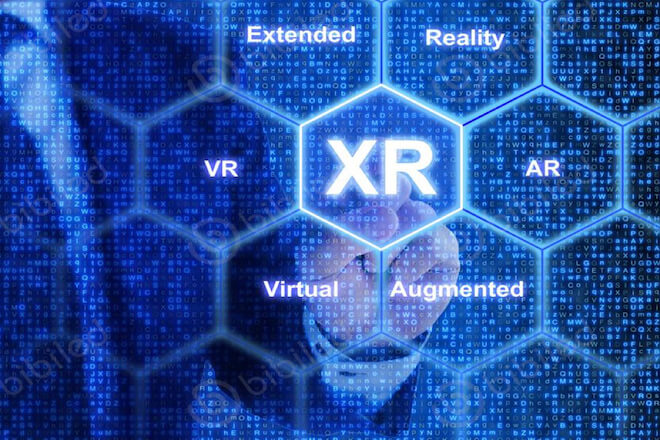
XR تعني الواقع الممتد، وهو مصطلح يشير إلى تقنية تجمع بين البيئات الافتراضية والحقيقية، في حين أن "X" تعني تقنية مستقبلية غير معروفة.
XR هي تقنية سريعة التطور مع تطبيقات إنتاج الأفلام والبث والترفيه المباشر والمزيد.
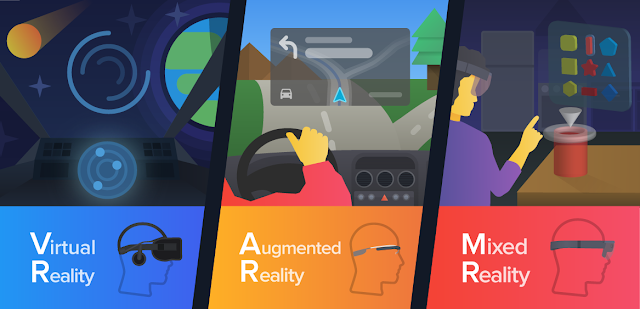
تغطي تقنية XR الواقع المعزز (AR)، والواقع الافتراضي (VR)، والواقع المختلط (MR).
- الواقع الافتراضي (VR): هو مزيج من الواقع الافتراضي والعرض، وهو نظام محاكاة حاسوبية يُمكّن من إنشاء عوالم افتراضية وتجربتها، مُنشئًا عالمًا افتراضيًا غامرًا تمامًا بتقنية 100% من خلال مدخلات المستشعر. إن الطبيعة التفاعلية ومتعددة الحواس لتقنية الواقع الافتراضي تجعلها شائعة لدى الكثيرين.
- الواقع المعزز (AR): تُمكّن تقنية الواقع المعزز من دمج المعلومات الافتراضية والعالم الحقيقي ببراعة، بحيث يتكاملان، مما يُحقق "تعزيزًا" للعالم الحقيقي. تتخذ الصور الافتراضية الواقع كجسم رئيسي، وتتراكب على بعضها البعض. وتستخدم هذه التقنية الوسائط المتعددة، والنمذجة ثلاثية الأبعاد، والتتبع الفوري، والتفاعل الذكي، وغيرها من الوسائل التقنية.
- MR (الواقع المختلط): تقدم هذه التقنية حلقة معلوماتية من ردود الفعل التفاعلية بين العالم الحقيقي والعالم الافتراضي والمستخدم، مما يساعد على تعزيز واقعية تجربة المستخدم. وببساطة، فإن MR هي بيئة بصرية جديدة تجمع بين العالمين الحقيقي والافتراضي.
2. ما هو تطبيق الواقع الممتد؟
مجال تطبيق XR واسع جدًا، وخاصةً فئة العرض.
من منظور شاشة LED، فإن التطبيق الرئيسي لـ XR هو في هذين الجانبين:
- مصابيح LED في الأفلام والبث
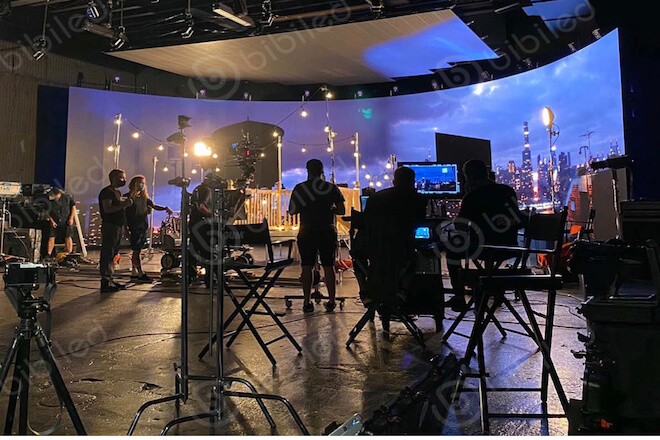
يتطلب إنتاج المساحة الافتراضية شاشات LED و شاشات LED أرضية لبناء مساحة مثالية؛ يمكن عرض المشاهد الديناميكية والمتقدمة من خلال شاشات LED، والتي تعد مفيدة جدًا للإنتاج الافتراضي والتصوير والبث.
- الإنتاج الافتراضي ومرحلة XR
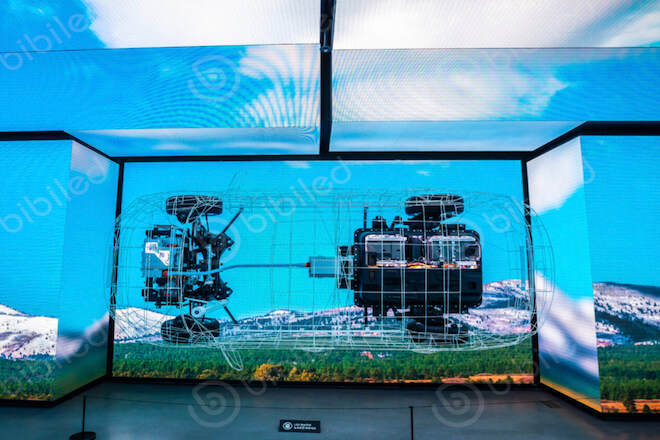
يمكن لمسرح XR استبدال الشاشة الخضراء عند البث المباشر، مما يسمح للمقدمين والحشود برؤية المشهد التفاعلي المباشر من حولهم بشكل ممتع للغاية لدرجة أن منظمي الحدث يرغبون في الاستفادة من التكنولوجيا الجديدة لتسهيل أعمالهم وجعلها سعيدة.
تعتبر شركة bibiled شركة تصنيع متقدمة لمعظم المؤسسات المشاركة في هذا الابتكار سريع النمو لتلبية التوقعات العالية.
3. ما هي مرحلة XR؟
تُعد مرحلة XR أحد تطبيقات جدار LED للإنتاج الافتراضي؛ يشير الإنتاج الافتراضي إلى المساحة والاستوديو مع سير عمل كامل بما في ذلك شاشات LED وخوادم الوسائط وأنظمة تتبع الكاميرا وأنظمة تحديد المواقع المكانية وأنظمة العرض في الوقت الفعلي لتوفير بيئات واقعية ممتدة ومنمقة لاستيعاب الإنتاجات الحية.
4. كيف تعمل مرحلة XR؟
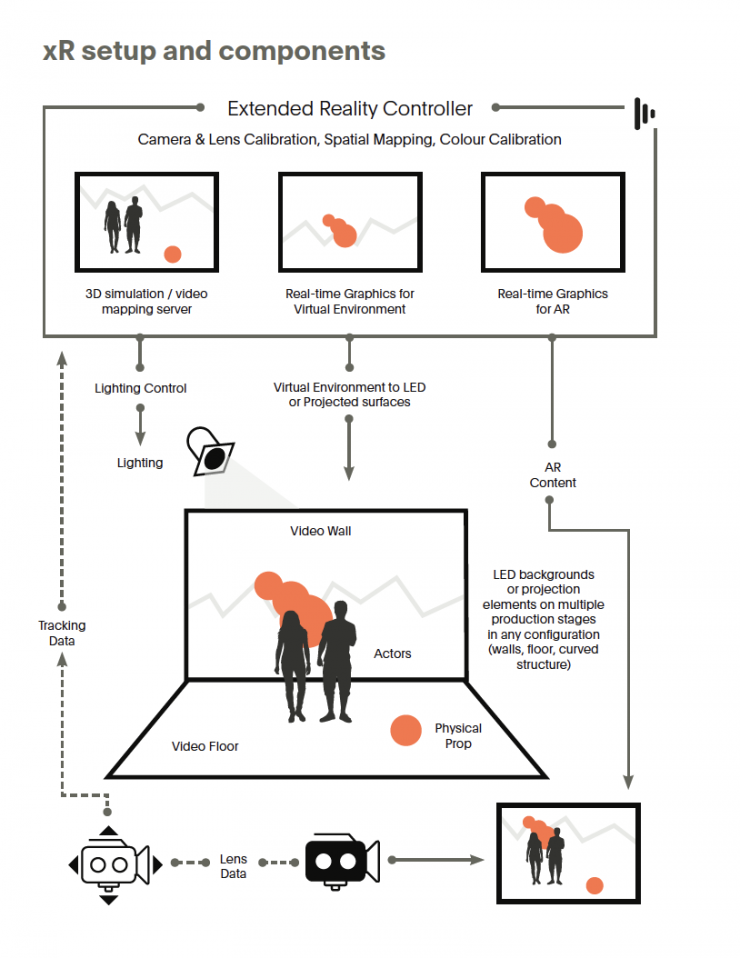 في إنتاج XR، يتم عرض بيئة افتراضية ثلاثية الأبعاد تم تكوينها مسبقًا بواسطة محرك رسومي على شاشة LED عالية الجودة واحدة (أو أكثر) تشكل الخلفية للأحداث الحية في العالم الحقيقي.
في إنتاج XR، يتم عرض بيئة افتراضية ثلاثية الأبعاد تم تكوينها مسبقًا بواسطة محرك رسومي على شاشة LED عالية الجودة واحدة (أو أكثر) تشكل الخلفية للأحداث الحية في العالم الحقيقي.
عند دمجها مع نظام تتبع الحركة الدقيق، يمكن للكاميرا التحرك داخل البيئة الافتراضية وحولها، مع دمج العناصر الحقيقية والافتراضية بسلاسة لخلق وهم التكوين.
5. فوائد مرحلة XR
- غامرة وقابلة للتعديل في الوقت الحقيقي
توفر مرحلة XR، جنبًا إلى جنب مع محرك الوقت الفعلي وتتبع الكاميرا وشاشة LED وتوسيع المشهد الافتراضي، فرصة غمر المواهب والفنانين في بيئة افتراضية ثلاثية الأبعاد، ويمكن تقديم الرسومات وعرضها على جدار الإنتاج الافتراضي LED، ويمكنك مشاهدة محتوى الفيديو بسرعة.
إن التحرير في الوقت الفعلي، والسماح للمحتوى بالظهور حول المؤدي في نفس الوقت، سيساهم بشكل كبير في تقليل وقت ما بعد الإنتاج والميزانية.
- معايرة أسرع للكاميرا
يمكن لمنصة XR معايرة نظام تتبع الكاميرا بشكل أسرع من الشاشة الخضراء التقليدية؛ مما يحسن بشكل كبير من كفاءة إعداد المشاهد عبر جلسات مختلفة.
- الإضاءة الطبيعية
تم إنشاء الإضاءة للفيلم بواسطة جدار الإنتاج الافتراضي LED نفسه على مسرح XR، مما يساعد عناصر العالم الحقيقي على الاندماج في البيئة الافتراضية دون قضاء الوقت والميزانية لإعداد أنظمة إضاءة إضافية؛ يساعد هذا في توفير الوقت وتقليل الميزانية، ولا يوجد تركيب مفتاح الكروما، وأكثر واقعية، وتقنية مفتاح الكروما التقليدية لها عيوب تقديم الصور غير الواقعية، وما بعد الإنتاج، وتكاليف الموظفين العالية.
تحل مرحلة XR هذه المشاكل بشكل مثالي.
- وفورات في التكاليف والسلامة
باستخدام XR Stage، يمكن إنشاء كافة المشاهد دون الحاجة إلى السفر إلى مواقع متعددة أو محاولة العثور على مواقع.
في عصر التباعد الاجتماعي وكوفيد-19، يمكن للبيئات الافتراضية أن تحافظ على سلامة الممثلين وطاقم العمل في بيئة خاضعة للرقابة، مع وجود عدد أقل من الأشخاص في المجموعة وتباعد اجتماعي أسهل واختبار كوفيد للموظفين.
6. أفضل 6 أوقات لاستخدام مسرح XR LED
- الحد الزمني
أحد أفضل الأوقات لاستخدام مسرح XR LED هو عندما يكون وقت معالجة الإنتاج لديك محدودًا.
لنفترض أنك بحاجة إلى تصوير مشاهد محددة، مثل غروب الشمس وشروقها، خلال نصف يوم، وهو أمر قد يكون صعبًا، ليس فقط بسبب مراعاة الطقس، بل أيضًا بسبب اختلاف الإضاءة بين الصباح والظهيرة، وصعوبة تحقيق مشهد مثالي. التصوير في الاستوديو على منصة XR LED لا يُساعد فقط في تقليل الوقت، بل يُقلل أيضًا من الوقت اللازم للحصول على الإضاءة المثالية. توفر جدران LED في الإنتاج الافتراضي إضاءة محيطية وانعكاسات دقيقة.
- مواقع متعددة مختلفة
وقت رائع آخر لاستخدام مرحلة XR LED هو عندما يتعين عليك التصوير في العديد من المواقع المختلفة في فترة قصيرة.
استخدم جدران LED لعرض خلفيات افتراضية؛ يمكنك بسهولة تغيير مجموعة متنوعة من الخلفيات الافتراضية الواقعية في أي وقت؛ على سبيل المثال، يمكن لفريقك اختيار التصوير في غابات الأمازون المطيرة صباحًا وقمة جبل إيفرست مساءً. هذا يُقلل من تكلفة التصوير في موقع التصوير ويُجنّبك عناء الظروف الجوية غير المتوقعة.
- المواقع الخطرة والمواقع التي تم إنشاؤها بواسطة الكمبيوتر
أفضل وقت لاستخدام مرحلة XR LED هو عند التصوير في مكان خطير.
تتطلب بعض مشاريع التصوير من فريق الإنتاج التصوير في مواقع خطيرة ومتطرفة مثل البراكين والوديان والصحاري والغابات البكر؛ ولإجراءات السلامة، يلزم تعيين المزيد من أفراد الأمن، مما يؤدي إلى زيادة كبيرة في التكاليف وأقساط التأمين.
- الحرية الإبداعية
أفضل وقت لاستخدام مرحلة XR LED هو عندما يرغب المخرج أو الفريق الإبداعي في مزيد من الحرية الإبداعية لتحقيق النتائج الأكثر مرغوبًا.
يمكن لفريقك الإبداعي الآن استخدام الدعائم والأزياء بأي لون في المشهد؛ وعند توليد الخلفية وتجسيدها حاسوبيًا، يمكن للمخرج طلب تعديلات إبداعية أو ضبطها بدقة في أي وقت. على سبيل المثال، إذا رأى المخرج أن البركان الافتراضي في الخلفية مرتفع جدًا، فيمكنه طلب تعديل ارتفاعه في أي وقت، ويمكن أن تنعكس هذه التعديلات بسرعة على شاشة LED.
- أحداث مباشرة غامرة
أفضل وقت لاستخدام مرحلة XR LED هو عندما تحتاج إلى بث حدث مباشر غامر مع رسومات أمامية في الوقت الفعلي وخلفيات افتراضية.
أثناء عملية التصوير، قد يقف المضيف المباشر على خشبة المسرح مع خلفية LED، مع التركيز على الجلوس أمام التلفزيون أو الكمبيوتر كـ "مضيف + شاشة افتراضية"، على سبيل المثال، قد يقف المضيف على قمة الجبل أو في مكان ما في الفضاء للبث المباشر.
- توفير تكاليف ما بعد الإنتاج والوقت.
أخيرًا، أحد أهم الأسباب التي تجعل معظم صناع الأفلام يتطلعون إلى إنتاج XR LED على المسرح هو لأنه يساعد في توفير تكاليف ما بعد الإنتاج والوقت.
غالبًا ما يُسمع صوت "التثبيت اللاحق" في موقع التصوير، وخاصةً بالنسبة للأفلام التي تعتمد بشكل مكثف على المؤثرات الخاصة، ويمكن أن يساعد الإنتاج الافتراضي باستخدام مصابيح XR LED في التخلص من مهمة التثبيت اللاحق التي تستغرق وقتًا طويلاً.
٧. شاشة LED افتراضية أم شاشة خضراء: أيهما أفضل للواقع المعزز؟
كانت الشاشات الخضراء ضرورية لإنتاج الأفلام والفعاليات؛ إلا أن شاشات LED الافتراضية أحدثت ثورة في الإنتاج الافتراضي وواقع XR الممتد، لذا إذا كانت معضلة شاشات LED الافتراضية والشاشات الخضراء تزعجك، فتابع القراءة لمعرفة المزيد.
ما هي شاشات LED الافتراضية والشاشات الخضراء؟
1. شاشة LED افتراضية
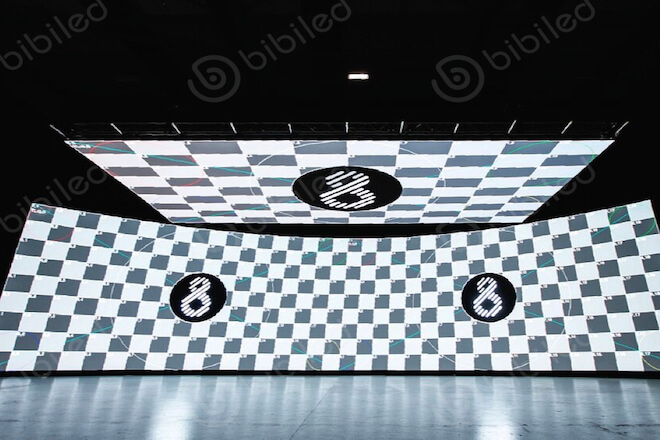
شاشة LED الافتراضية هي ابتكار في تكنولوجيا ثلاثية الأبعاد؛ يمكنها المساعدة في إنشاء مجموعة متنوعة من السمات التي تريدها من خلال العرض باستخدام محرك ثلاثي الأبعاد في الوقت الفعلي لتحقيق مشهد افتراضي يتم فيه دمج الأشخاص الحقيقيين والمشاهد الخيالية بشكل كامل، وبالتالي فإن ما تصوره هو ما تحصل عليه.
2. الشاشة الخضراء
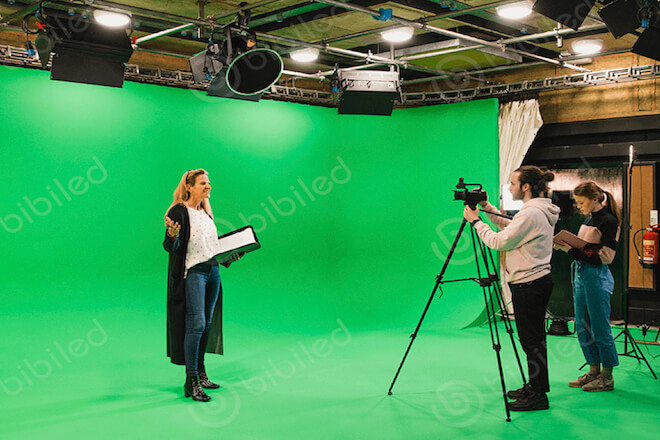
تقنية الشاشة الخضراء هي تقنية كروما كيينغ، والتي تتضمن استخدام جدار عادي كخلفية، مع وضع جسم أو أجسام نشطة أمام الشاشة. خلال مرحلة ما بعد الإنتاج، تُستبدل الألوان الصلبة بالخلفية المطلوبة، وهي تقنية مستخدمة منذ سنوات في صناعات الألعاب والوسائط.
أوجه التشابه والاختلاف بين شاشة LED الافتراضية والشاشة الخضراء
1. التشابه
يمكن استخدام الشاشة الخضراء وشاشة LED الافتراضية كخلفية للتصوير، ويمكن تكبير الإطار وتصغيره.
2. الفرق
1) الفرق في التكلفة الإجمالية:
وبشكل عام، فإن سعر شراء شاشة LED عالية الدقة أعلى بكثير من سعر الشاشة الخضراء.
ولكن على المدى الطويل، تعتبر شاشات LED أكثر تنوعًا وأرخص من الشاشات الخضراء.
لماذا؟
تتطلب مرحلة ما بعد إنتاج الشاشات الخضراء رأس مال ومدخلات بشرية أكثر من شاشات LED، ويجب على كل حدث أن يأخذ هذا العامل في الاعتبار، كما أن إنتاج الشاشات الخضراء ليس رخيصًا.
يمكن للإنتاج الافتراضي أن يقلل بشكل فعال من تكاليف نقل الطاقم وتكاليف الانتظار البيئية لتصوير الموقع.
2) الفرق بين مرحلة ما بعد التحرير ومرحلة التحرير أثناء الإنتاج:
تتمتع تقنية التصوير بالشاشة الخضراء بتاريخ طويل ولعبت دورًا مهمًا قبل أن تصبح شاشات LED شائعة في تصوير الأفلام والتلفزيون.
يُركز تصوير القماش الأخضر على المعالجة اللاحقة، وعادةً ما يؤدي الممثلون أدوارهم بخيال أمام شاشة خضراء/زرقاء. بعد المعالجة اللاحقة على الكمبيوتر، يتمكن المخرج من رؤية الصورة النهائية بعد دمج الأداء والمؤثرات الخاصة.
تتميز طريقة التصوير باستخدام شاشة LED كخلفية بخصائص الوقت الحقيقي.
يمكنك رؤية الكاميرات التالية أثناء حركة المجموعة، وتحقيق تتبع بصري دقيق وواقعي، وتحرير المحتوى المعروض على الشاشة في الوقت الفعلي. يتيح التصوير بتقنية XR للمخرج تجربة الصورة المباشرة في الوقت الفعلي، مما يُختصر سير العمل ويُقلل بشكل كبير من عبء العمل في مرحلة ما بعد الإنتاج.
3) قم بتصوير الفرق في عملية الإنتاج
-التصوير بالشاشة الخضراء التقليدية:
- ضع الخلفية المادية وقم ببناء خلفية الشاشة الخضراء
- التقاط محتوى الفيديو
- إجراء معالجة لاحقة للفيديو، بما في ذلك المحتوى الخلفي والنمذجة
- الإنتاج الكامل
– لقطة خلفية لشاشة LED:
- بناء استوديو العرض LED.
- تصوير محتوى الفيديو، وعرض متزامن في الوقت الفعلي بتقنية XR
- الإنتاج الكامل
مزايا استخدام شاشات LED الافتراضية مقارنة بالشاشات الخضراء في الواقع المعزز XR
1. عرض في الوقت الحقيقي
في الماضي، كان إنتاج الأفلام يتم بمرحلة ما قبل التصوير قبل استخدام الشاشة الخضراء، تليها مرحلة ما بعد الإنتاج وتحرير المؤثرات الخاصة. أما الآن، فمع شاشات LED، تتيح الإنتاجات الافتراضية دمج المشاهد الحقيقية مع المشاهد الخيالية لعرضها وتحريرها في الوقت الفعلي.
2. تحسين الإبداع
إن الإنتاج الافتراضي لشاشات LED الافتراضية يمكن أن يحرر مبدعي الأفلام والتلفزيون؛ فلم يعد الممثلون بحاجة إلى الاعتماد على الخيال في الأداء، ويمكن للمخرجين الإبداع بحرية حقيقية.
3. العملية الإبداعية المبتكرة
لا يحتاج الجزء الافتراضي من العمل إلى الانفصال عن التصوير الفعلي، إذ يمكن للمنتج مشاهدة اللقطات النهائية والمحتوى فورًا. كما تتخطى شاشة LED قيود المساحة، ولا يحتاج المنتج للبحث عن مواقع تصوير مناسبة حول العالم.
٨. كيفية بناء جدار فيديو LED، ومنصة XR، والإنتاج الافتراضي (أنواع جدار XR LED)

يمكن تخصيص جدران XR LED لتلبية متطلباتك الفريدة وفقًا للتثبيت والإعداد؛ لدينا عادةً جدران LED منحنية وجدران LED زاوية وشاشات LED إبداعية.
9. سير عمل الإنتاج الافتراضي XR
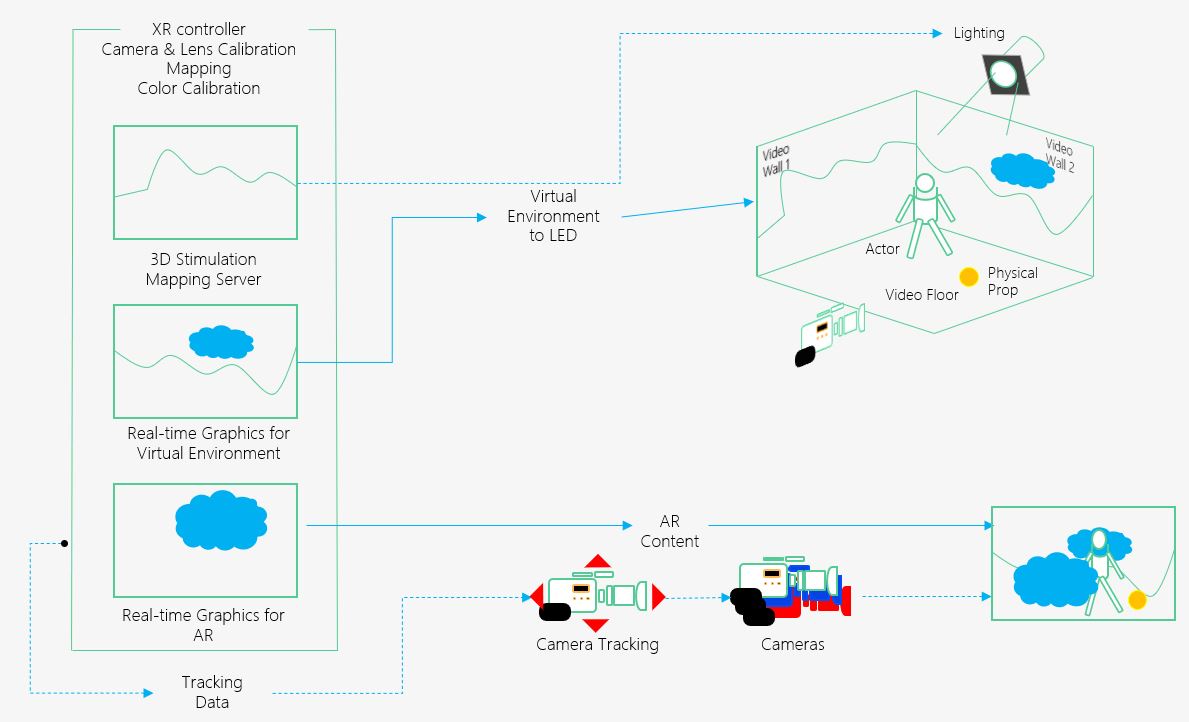
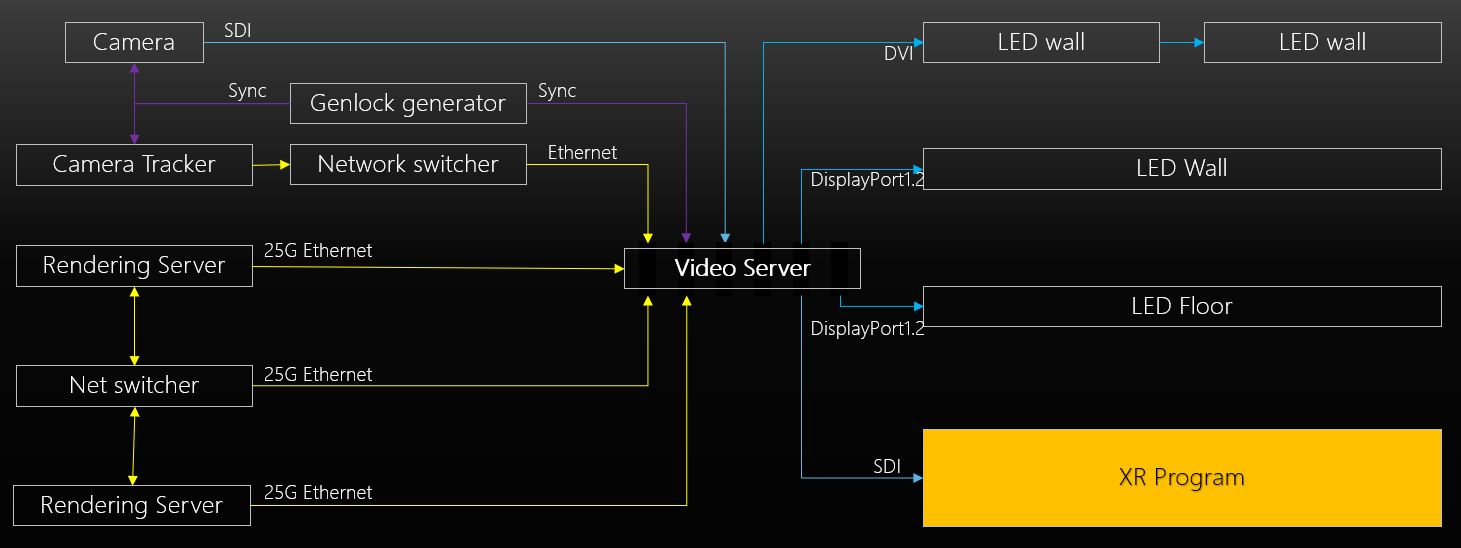
يُعد جدار LED بمثابة قلب مسرح XR.
تساعد جدران LED على ضمان جودة صورة ممتازة مع نطاق ألوان أوسع وسطوع عالي.
وتشمل المكونات المهمة الأخرى أنظمة تتبع الكاميرات، ووحدات التحكم، ومحركات الرسومات، وخوادم العرض، وأنابيب الإنتاج الافتراضية.
10. دراسة حالة لمرحلة الإنتاج الافتراضي XR
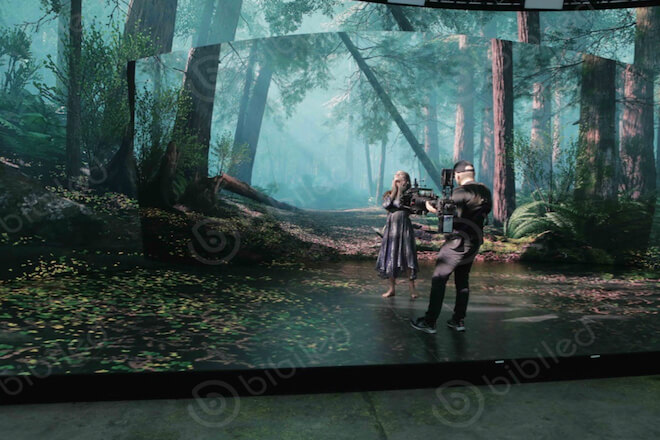
1) تم إطلاق استوديو RPG الخاص بـ MADO Xr في باريس في يناير 2021، وهو أحد أكبر استوديوهات XR في فرنسا، ويقع في استوديو الأفلام الذي تبلغ مساحته 800 متر مربع في Epinay.
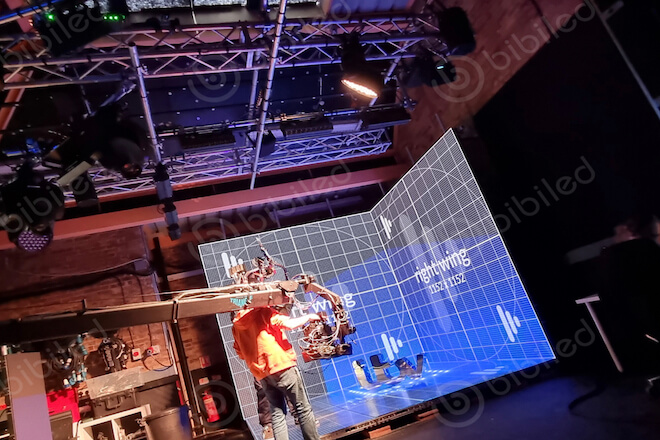
2) يقع استوديو XR Labs في Old Dairy Court بالقرب من وسط لندن بالمملكة المتحدة، وهو عبارة عن استوديو XR صغير دائم يعمل بشكل وثيق مع جميع سير عمل XR الشهيرة (Unreal وNotch وUnity) مع BBC ITV.
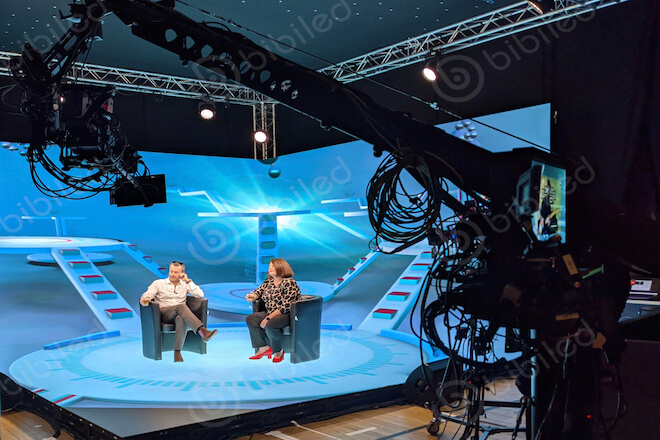
3) تم تصميم SmartStage من White Light في Mermaid، لندن، المملكة المتحدة، لسير العمل "الطبيعي الجديد"؛ يستضيف SmartStage من White Light إعلان جولة UK & Ireland Lions 2021، والبرنامج التجريبي لبث 'Famous' على قناة BBC، ومهرجان BDO Rethink من Fusion Comms، وهو مؤتمر افتراضي عالمي يحضره أكثر من 2500 مندوب.
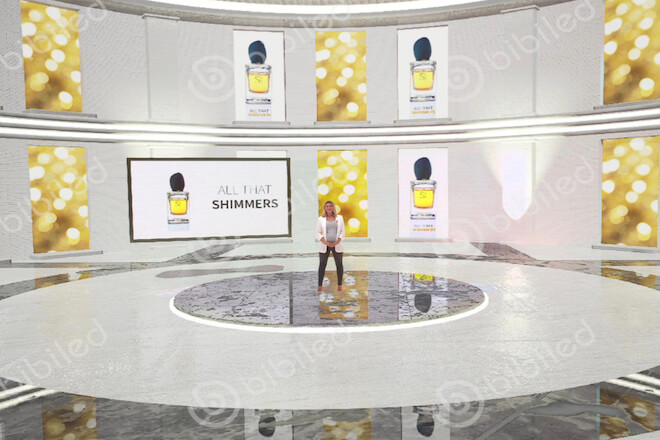
4) يوفر SmartStudioXR في فندق Royal Lancaster في لندن بالمملكة المتحدة خلفية فريدة للعملاء من الشركات، حيث يتميز بمساحة كبيرة للحدث مع خلفيات LED وأرضيات ومعدات XR.
11. ما هي النقاط الفنية التي يجب أن نكون حذرين بشأن شاشة LED لمرحلة XR؟
- تصحيح الألوان
يجب أن تضمن شاشة العرض LED دقة الألوان الحقيقية، ويجب أن تتراوح قيمة درجة حرارة اللون بين 6300 كلفن و6500 كلفن.
- سطوع عالي، يحاكي مصدر الضوء الحقيقي.
إذا قمت بمحاكاة مصدر الضوء مباشرة في العالم الحقيقي باستخدام سطوع عالي، فيمكنك توفير عبء العمل المتعلق بالإضاءة، ولن تحتاج إلى قضاء وقت طويل في مرحلة ما بعد الإنتاج لإكمال العمل.
- أداء عرض عالي الجودة
يعد الأداء المرئي عالي الجودة هو الأساس، لذلك من المهم جدًا اختيار الملحقات الإلكترونية الداخلية المستقرة، مثل العلامات التجارية الأكثر موثوقية في الصين، وحبات مصباح Guoxing، وإمدادات الطاقة Mingwei، وما إلى ذلك.
- تأثير التموج
يرتبط تأثير المواريه بدرجة دقة البكسل، وهي مشكلة صعبة للغاية في إنتاج LED الافتراضي، ولدينا بعض الحلول للتعامل معها، مثل استخدام الشاشة الخضراء مؤقتًا كخلفية.
الطريقة الأكثر موثوقية هي العثور على مصور محترف لحل هذه المشكلة وفقًا للموقف المحدد للمشهد، مثل العثور على المسافة الصحيحة بين العدسة والشاشة.
- رمش
الحل الأكثر استهدافًا هو العثور على شاشة LED عالية الجودة تومض بشكل أقل، ويمكن للمصورين ضبط سرعة الغالق إلى 1/60 من الثانية نظرًا لأن شاشات LED العادية تعمل عادةً بتردد 60 هرتز.
12. كم تكلفة شاشة XR Stage LED؟
تعتمد تكلفة شاشة مسرح XR أو نظام حائط LED للإنتاج الافتراضي على مساحة أو حجم شاشة LED المستخدمة لمرحلة XR ومعالج الفيديو ونظام التعليق/التكديس.
مع وجود العديد من القرارات التي تؤثر على التكلفة النهائية، فمن المهم فهمها قبل اختيار هذه الأنظمة.
على سبيل المثال، خذ BIBILED 500، 2.6 مم مع نظام التحكم Brompton.
- حجم الشاشة: جانبان، يسار/يمين، 7م × 5م، وحدتان، 70 متر مربع
- سعر الشاشة، ماتريكس 2.6 مم، 70 متر مربع، $150,000
- المعالج، Tessera S4/S8، 4 مجموعات، 1.4 ألف دولار أمريكي - 3 آلاف دولار أمريكي
- نظام التعليق/التكديس: 2000 دولار أمريكي/12000 دولار أمريكي
13. تاريخ XR Virtual LED
كما ذكرنا في الفصل الأول سابقًا، تتضمن تقنية XR الواقع المعزز (AR)، والواقع الافتراضي (VR)، والواقع المختلط (MR)، وهي سلسلة من التقنيات الغامرة التي يعود تاريخها إلى القرن التاسع عشر.
يصف هذا الفصل بإيجاز المعالم الرئيسية في تطوير XR:
1) القرن التاسع عشر:
- في عام 1838، حدد العالم السير تشارلز ويتستون مفهوم "الرؤية المجسمة" أو "الرؤية الثنائية" - يجمع الدماغ صورتين (واحدة لكل عين) في صورة ثلاثية الأبعاد، مما يسهل التطوير الأول لجهاز التصوير المجسم، وهو جهاز يأخذ زوجًا من الصور ويحولها إلى صورة ثلاثية الأبعاد مع وهم العمق، على غرار الطريقة التي تستخدم بها أنظمة الواقع الافتراضي اليوم شاشات العرض المجسمة.
- القرن العشرين: في عام 1935، نشر كاتب الخيال العلمي الأمريكي آنذاك ستانلي وينباوم رواية "نظارات بيجماليون"، حيث يستكشف بطل الرواية عالمًا خياليًا باستخدام زوج من النظارات، وهو أول تنبؤ بالواقع الافتراضي كما نعرفه اليوم.
2) من الخمسينيات إلى السبعينيات
- في الخمسينيات والستينيات والسبعينيات، شهدنا ظهور تقنية الواقع الافتراضي في مراحلها المبكرة وبعض الأمثلة العملية لتقنية الواقع المعزز.
- في عام 1956، ابتكر المصور السينمائي مورتون هيليج أول جهاز واقع افتراضي، Sensorama، وهو فيلم يجمع بين الفيديو الملون ثلاثي الأبعاد (تكنولوجيا الصور المجسمة) مع الصوت والروائح وكرسي مهتز لغمر الجمهور في الفيلم.
- في عام 1960، حصل هايليج على براءة اختراع أول شاشة مثبتة على الرأس - تجمع بين الصور المجسمة ثلاثية الأبعاد والصوت المجسم.
- في عام 1960، بناءً على الفكرة الإبداعية التي طرحها هايليج، ابتكر مهندسو شركة فيلكو أول سماعة رأس للواقع الافتراضي مزودة بتقنية تتبع الحركة مصممة للاستخدام العسكري في عام 1961.
- في عام 1968، ابتكر أستاذ جامعة هارفارد إيفان سوثرلاند أول سماعة رأس للواقع المعزز، ليصبح بذلك من أوائل رواد تجارب الواقع المعزز اليوم.
- في عام 1970، أنشأ معهد ماساتشوستس للتكنولوجيا خريطة أسبن السينمائية لإظهار لأول مرة كيف يمكن للواقع الافتراضي نقل المستخدمين إلى مكان آخر تمامًا.
3) من ثمانينيات القرن العشرين إلى العقد الأول من القرن الحادي والعشرين
- في عام 1980، تم تحسين تكنولوجيا تجربة الواقع الافتراضي.
- في عام 1985، أصبحت شركة VPL Research Inc أول شركة تبيع نظارات وقفازات الواقع الافتراضي.
- في عام 1987، تمت صياغة مصطلح "الواقع الافتراضي".
- في أوائل تسعينيات القرن العشرين، بدأت الأسر العادية في شراء سماعات الواقع الافتراضي، في حين تم استخدام الواقع المعزز بشكل أساسي في المباريات الحية وغيرها من البث الرياضي.
4) 2010 إلى 2020
لم يكن الكثير من الناس في أوائل العقد الأول من القرن الحادي والعشرين يفهمون تقنية XR جيدًا، ولكن بدءًا من عام 2010، بدأت تقنية XR تكتسب زخمًا:
- في عام 2010، قام بالمر لوكي البالغ من العمر 18 عامًا بتصميم النموذج الأولي لسماعة الرأس Oculus Rift VR، وهي سماعة رأس ثورية أشعلت الاهتمام بالواقع الافتراضي بفضل مجال رؤيتها الذي يبلغ 90 درجة وقوة معالجة الكمبيوتر.
- في عام 2014، أعلنت شركة سوني وسامسونج أنهما تعملان على تطوير سماعات الواقع الافتراضي الخاصة بهما.
- في عام 2016، قامت مئات الشركات بتطوير تجارب الواقع الافتراضي والواقع المعزز، وكان أيضًا العام الذي جلبت فيه ألعاب Pokémon GO الواقع المعزز إلى التيار الرئيسي.
- يشهد الواقع الافتراضي والواقع المعزز والواقع المختلط توسعًا سريعًا عبر مختلف الصناعات.
اليوم، يتم اعتماد تقنية XR في مختلف المجالات بدءًا من التصنيع والتعليم والرعاية الصحية والبناء وحتى إنفاذ القانون.
14. لماذا سيكون جدار BIBILED الحل الأمثل لمسرح XR؟
شاشة العرض BIBILED هي مرحلة XR مصممة خصيصًا لمؤتمراتك الافتراضية الغامرة وفعاليات الشركات ومقاطع الفيديو الموسيقية.
باعتبارنا شركة عالمية مصنعة لتقنية LED ذات الدقة العالية، فإننا قادرون على تصميم مجموعات أو مراحل أو استوديوهات لأي إنتاج افتراضي ونعتبر شريكًا تعاقديًا مستقرًا للإنتاجات الافتراضية.
15. حلول BIBILED الموصى بها
ختاماً:
ما ورد أعلاه هو مقدمة مفصلة لـ مرحلة XRنقوم بتحليل تقنية XR، وتطبيقاتها، وأسباب استخدامها، وما إلى ذلك، من 13 جانبًا.
سيصبح الجمع بين العالمين الواقعي والافتراضي رائجًا في الأفلام وفعاليات الأعمال. لماذا لا نستغل هذه الفرصة الإبداعية لنتألق في أعمالنا؟
إذا كان لديك أي أسئلة حول مرحلة XR، يمكنك ترك رسالة أدناه أو اترك معلوماتكوسوف نقوم بالرد عليك في أقرب وقت ممكن.
